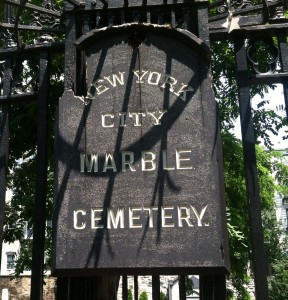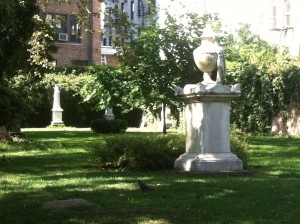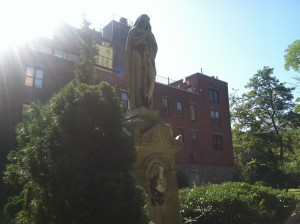Blog Archive
A Walk Among the Tombstones… in the Historic Lower East Side
With Halloween rapidly approaching in 24 hours it only seems appropriate for us to write about the New York City Marble Cemetery located in the historic Lower East Side (aka the East Village). Now when you think of New York City you tend to associate it with skyscrapers, tenements, taxi cabs, hot dog vendors, and the films of Spike Lee or Woody Allen (no disrespect to you fans of Midnight In Paris and Vicky Cristina Barcelona). One thing you don’t associate with Manhattan is a cemetery.
 Yet among the apartments and buildings on Second Avenue, you will very quietly come across the historic New York City Marble Cemetery, which is one of the few still active cemeteries in the city. Recently, we at the Tenement Museum were fortunate enough to get a rare tour of the cemetery – so rare in fact that rumor has it years ago they turned down The Rolling Stones who wanted to shoot a video there – to find out more about its fascinating history. The folks at the cemetery also allowed us to take some photographs which we will be posting in this blog.
Yet among the apartments and buildings on Second Avenue, you will very quietly come across the historic New York City Marble Cemetery, which is one of the few still active cemeteries in the city. Recently, we at the Tenement Museum were fortunate enough to get a rare tour of the cemetery – so rare in fact that rumor has it years ago they turned down The Rolling Stones who wanted to shoot a video there – to find out more about its fascinating history. The folks at the cemetery also allowed us to take some photographs which we will be posting in this blog.
Now let’s get one very confusing thing out of the way. There is The New York Marble Cemetery which is located one block away at 41 ½ Second Avenue that is not visible to the general public. We aren’t going to be discussing that cemetery. The cemetery we are going to discuss is called New York City Marble Cemetery and is located at 52-74 East 2nd Street between First and Second Avenues. It’s confusing because besides being similar in name and location, they also were founded one year apart with The New York Marble Cemetery opening in 1830 and New York City Marble Cemetery opening in 1831. Similarities aside, they are completely independent of one another.
When the New York City Marble Cemetery opened its gates – or should I say its tombs – in 1831, it was the second non-sectarian burial ground in New York City opened to the public after The New York Marble Cemetery. Similar to The New York Marble Cemetery, the cemetery buried its dead in specially constructed underground marble vaults, made specifically from Tuckahoe marble (yes, from Tuckahoe, NY). This was a result of the yellow fever outbreak in 1830 that caused many residents to fear burying their dead in the traditional way: casket a few feet below ground. To this day, the cemetery continues to bury its dead this way.
When the cemetery first opened, it was a highly sought after location to spend your eternal days. Monuments and markers were permitted to signify the location of specific family vaults. There are many well-known New Yorkers who are buried in New York City Marble Cemetery that include Stephen Allen, the one-time mayor of the City and governor of New York; James Lenox, who was one of the founders of The New York Public Library; and a well-known New York merchant in mercantile and shipping named Preserved Fish. Yes, his actual name was Preserved Fish… awesome, isn’t it? 
But with all due respect to these men of great reputation and success, the biggest and most important name ever buried in the cemetery was that of former President of the United States, James Monroe. After the death of his wife, Monroe moved to New York to live with his son-in-law who happened to own a vault in the cemetery. When Monroe died in 1831, he became one of the first people buried in New York City Marble Cemetery, and because of the attention his death received, it raised the profile of the cemetery. However, even in death nothing is eternal, and in 1858 Monroe’s home state of Virginia passed a resolution to have the President’s remains returned to the state and reburied at Hollywood Cemetery in Richmond. The cemetery’s most famous internment had left the building…or should I say graveyard.
Today, besides being an active cemetery, the New York City Marble Cemetery does in fact give occasional tours and host special events. Yes, they even will host the occasional wedding. If you are DYING to visit the cemetery you can find out more at their website www.nycmc.org
– Post by Jon Pace
